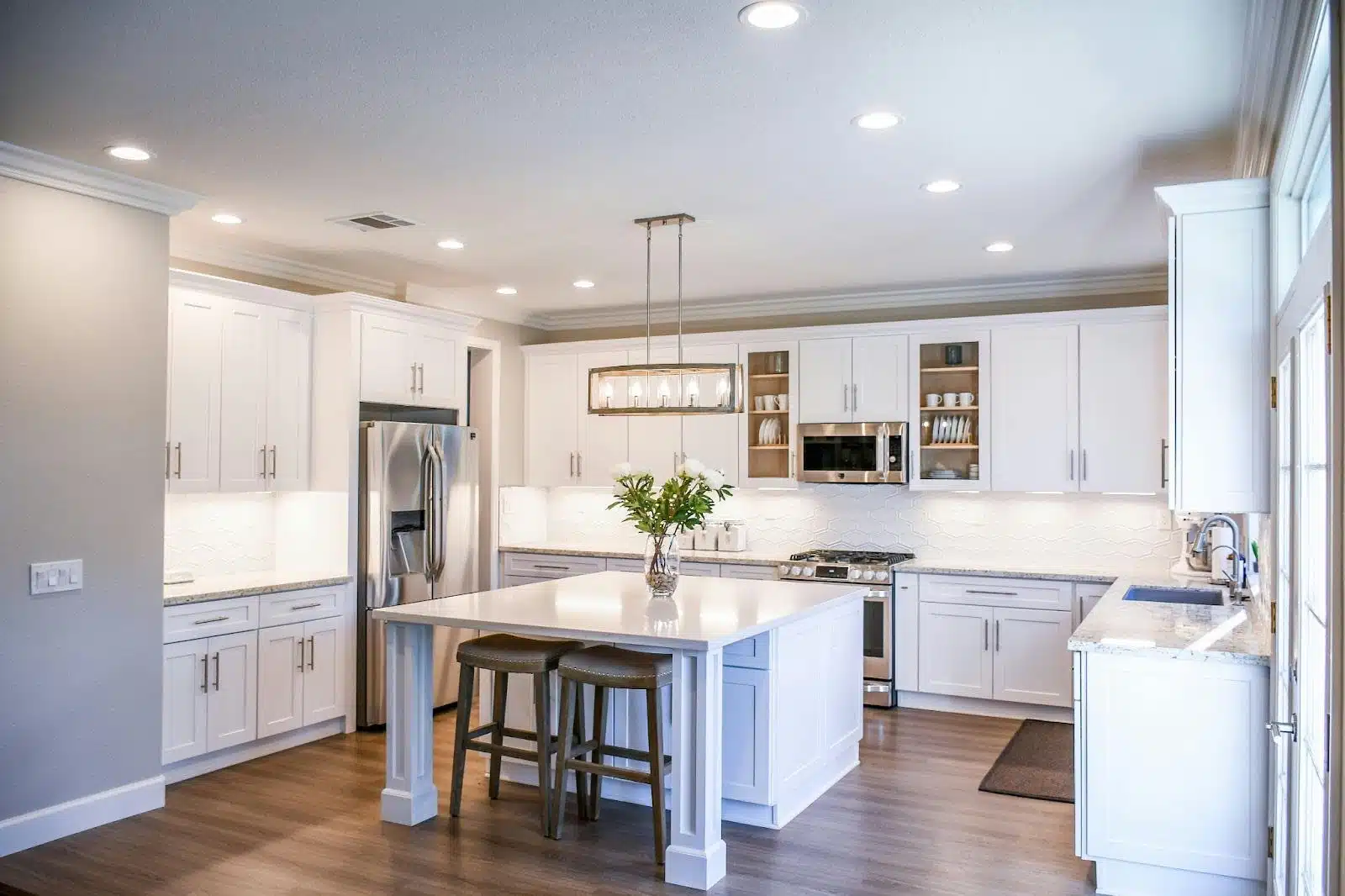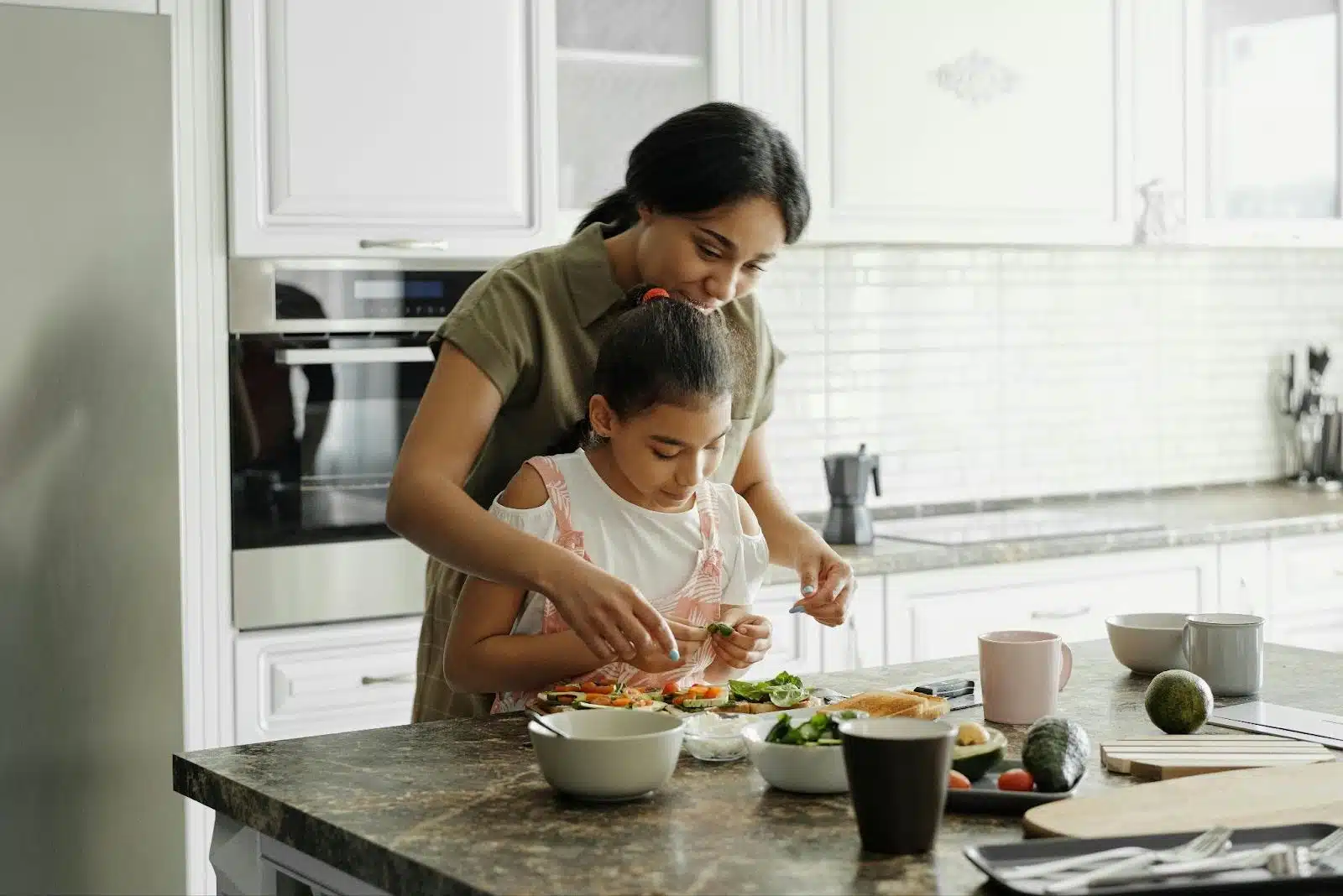
Crafting the Perfect Kitchen Layout: A Beginner’s Guide
In any home, the kitchen is a central hub where meals are prepared, memories are made, and families gather.
Crafting the perfect kitchen layout requires careful planning and consideration. Whether renovating an existing kitchen or starting from scratch, this beginner’s guide will provide valuable insights and tips to create a functional and aesthetically pleasing space.
McManus Kitchen and Bath is a full service remodeling company with an in-house design team and showroom right here in Tallahassee, FL.
If you’re ready to invest in your home and want to work with a company that pays attention to details and provides excellent customer service, schedule a discovery call.
Key Takeaways: Kitchen Layout
- There are 5 Basic kitchen layouts
- Kitchen size has an impact on layout
- The work triangle and work zones are two good organizing principles
Understanding Kitchen Layouts
Before diving into the details, it’s important to understand the importance of a well-planned kitchen layout. A thoughtfully designed kitchen enhances efficiency and improves overall usability and enjoyment. By optimizing the flow and organization of your kitchen, you can save time and effort in meal preparation and create a space that suits your lifestyle.
The Importance of a Well-Planned Kitchen
A well-planned kitchen layout considers factors such as workflow, functionality, and accessibility. It ensures that essential kitchen tasks, such as cooking, cleaning, and storage, are conveniently located and easily accessible. Additionally, a well-designed kitchen can increase your home’s value and make it more appealing to potential buyers.
Basic Kitchen Layout Types
There are several common kitchen layout types, each with its advantages and considerations. The most popular layout types include:
- One-Wall Layout: This layout places all appliances and cabinets along a single wall for small spaces or open-plan living.
- Galley Layout: Perfect for narrow spaces, this layout features two parallel walls of cabinets, creating an efficient workflow.
- L-Shaped Layout: This layout utilizes two adjacent walls and provides plenty of counter and storage space.
- U-Shaped Layout: This layout forms a “U” shape and is suitable for larger kitchens, offering ample counter space and storage.
- Island Layout: Incorporating a central island, this layout provides additional workspace and storage.
When choosing a kitchen layout, it’s important to consider your specific needs and preferences. For example, if you love hosting dinner parties and entertaining guests, an island layout can provide a central gathering space where people can mingle while you prepare food. On the other hand, if you have a small kitchen and limited space, a one-wall layout can help maximize the available area without compromising functionality.
Another important factor to consider is the kitchen’s proximity to other areas of your home. For instance, if you frequently cook while keeping an eye on your children in the living room, an open-plan layout that connects the kitchen to the living area can be a great choice. This way, you can easily supervise your little ones while still being able to prepare meals.
Ultimately, the key to a successful kitchen layout is finding the right balance between functionality, aesthetics, and personal preferences. By carefully considering your needs and exploring different layout options, you can create a kitchen that meets your practical requirements and reflects your unique style and personality.
Work Triangle Vs Work Zones
The work triangle has long been a central feature in kitchen design. But as kitchens grow larger work zones have become more prevalent.
Starting Your Kitchen Layout Plan
Now that you understand the basics of kitchen layouts, it’s time to start planning your own. Here are the initial steps to get you started:
Assessing Your Current Kitchen
Before making any design decisions, assess your current kitchen’s strengths and weaknesses. Consider the layout and flow of your existing space, noting any areas that need improvement or upgrades. Measure the existing layout, including the dimensions of walls, windows, and doors. This will help you visualize the space and identify any potential challenges.
When assessing your current kitchen, consider how natural light enters the space throughout the day. Consider the views from your windows and how they enhance or detract from your cooking experience.
Additionally, evaluate the functionality of your current storage solutions and how well they accommodate your cookware, utensils, and pantry items. Understanding these aspects will inform your decisions when redesigning your kitchen layout.
Identifying Your Needs and Wants
Next, list your needs and wants for your new kitchen layout. Consider your cooking style, lifestyle, and family size. Are you an avid cook who requires ample countertop space? Do you entertain frequently and need space for guests to gather? Identifying your needs and wants will guide your decision-making process and help you prioritize the elements that are most important to you.
Think about the appliances you use regularly and how they should be integrated into your new kitchen design. Whether you dream of a professional-grade range or a spacious refrigerator, understanding your appliance requirements will ensure that your new layout is both functional and aesthetically pleasing.
Additionally, consider any special features or design elements that enhance your cooking experience, such as a dedicated coffee station or a built-in wine cooler. By envisioning your ideal kitchen space, you can create a layout that truly reflects your personal style and culinary preferences.

Your content goes here. Edit or remove this text inline or in the module Content settings.
Key Elements of a Functional Kitchen Layout
When designing a functional kitchen layout, it’s crucial to consider various elements that can enhance the space’s efficiency and usability. In addition to the standard features, there are additional factors to keep in mind to create a truly optimized kitchen environment.
The Kitchen Work Triangle
The kitchen work triangle concept is a fundamental principle in kitchen design, but it’s also important to think beyond just the basic triangle layout. Consider the flow of movement within the kitchen space and how different work zones interact. By fine-tuning the placement of key elements like the sink, refrigerator, and cooking range, you can further streamline your workflow and make meal preparation a seamless process.
Storage Solutions and Organization
While storage solutions are critical in kitchen functionality, it’s about more than just having ample storage space. Consider your household’s specific needs and cooking habits to optimize your kitchen storage.
Customizing storage options to accommodate your cookware, utensils, and pantry items can significantly affect how efficiently you can access and utilize your kitchen tools. Additionally, incorporating organizational tools like drawer dividers, spice racks, and labeling systems can help maintain order and make it easier to find what you need when you need it.
Another aspect to consider is integrating smart storage solutions that cater to modern kitchen requirements. Features like pull-out trash bins, corner cabinet carousels, and appliance garages can add convenience and functionality to your kitchen layout.
By combining traditional storage methods with innovative organizational solutions, you can create a kitchen that looks great and functions seamlessly to support your culinary endeavors.
Want Some Inspiration In Your Inbox?
Designing for Different Kitchen Sizes
When designing a kitchen, the size of the space plays a crucial role in determining the layout and functionality. Whether your kitchen is small or large, there are design considerations to optimize the space:
Making the Most of Small Kitchens
In small kitchens, every inch counts. Maximizing storage and work areas is essential to prevent the space from feeling cramped. Consider space-saving solutions, such as utilizing vertical storage with tall cabinets or shelves. Compact appliances like slim refrigerators or combination microwave-convection ovens can also help free up valuable counter space.
Additionally, incorporating multifunctional furniture, such as a fold-down dining table or a kitchen island with built-in storage, can provide versatility in a small kitchen. Lighter color schemes and reflective surfaces, such as glossy backsplashes or mirrored cabinet doors, can also create an illusion of spaciousness by bouncing light around the room.
Optimizing the layout by placing frequently used items within easy reach and keeping the kitchen well-organized can make a significant difference in a small kitchen. Consider using magnetic strips or hooks to hang utensils, pot racks to store cookware overhead, and drawer dividers to keep small items like spices and utensils in order.
Planning for Large Kitchens
When designing a large kitchen, the focus shifts towards creating a cohesive layout that balances functionality and aesthetics. With more space, defining distinct zones for cooking, dining, and gathering is essential to ensure a seamless flow of activities.
Incorporating an island or a peninsula can provide additional workspace for meal prep and serve as a casual dining area. Consider using different materials or finishes for cabinetry, countertops, or flooring to delineate different areas within the kitchen, creating visual interest and defining each zone’s purpose.
Ample lighting is key to effectively illuminating a large kitchen. Combining ambient, task, and accent lighting can enhance the kitchen’s functionality and ambiance. Pendant lights above the island or under-cabinet lighting along the countertops can add style and functionality to the space.
Additionally, integrating smart technology, such as motion-sensor faucets or smart appliances, can elevate the kitchen’s convenience and efficiency, catering to modern lifestyle needs.
Choosing the Right Appliances and Fixtures
The selection of appliances and fixtures is key to a functional kitchen layout. Consider the following:
Selecting Appliances for Your Layout
Choose appliances that fit seamlessly into your kitchen layout and meet your needs. Consider appliances’ size, type, and placement to ensure maximum efficiency. For example, a built-in oven and microwave can save valuable counter space, while a dishwasher near the sink simplifies clean-up.
When selecting appliances, also consider their energy efficiency ratings. Opting for Energy Star certified appliances can reduce your carbon footprint and save you money on utility bills in the long run. Additionally, consider the finish of the appliances to ensure they complement the overall aesthetic of your kitchen.
The Role of Lighting in Your Kitchen
Lighting is an often overlooked but essential element in kitchen design. To create a well-lit and inviting space, incorporate a combination of task, ambient, and accent lighting. Consider installing under-cabinet lights to illuminate work areas and pendant lights to add visual interest.
Another important aspect to consider when planning your kitchen lighting is the color temperature of the bulbs. Warmer tones (measured in Kelvins) create a cozy atmosphere, while cooler tones are more energizing. Dimmer switches can also provide flexibility, allowing you to adjust the lighting levels based on the time of day or the desired ambiance.
Conclusion
Crafting the perfect kitchen layout is an exciting endeavor that requires careful planning and consideration. By understanding the different kitchen layout types, assessing your needs and wants, and incorporating key elements of functionality, you can create an efficient and aesthetically pleasing kitchen. Remember to design for your specific kitchen size, choose the right appliances and fixtures, and pay attention to lighting. With these tips in mind, you’ll be well on your way to crafting your dream kitchen.
Are you ready to turn your dream kitchen into reality? Schedule a Discovery Call with us at McManus Kitchen and Bath to get started! Learn about our consult process and fees and how we can make your dream kitchen a reality. With our full-service, stress-free approach from start to finish, you’ll have one point of contact and one showroom to streamline the process. Contact us today to begin your kitchen redesign journey.
